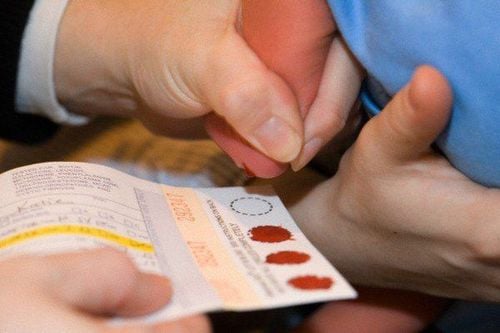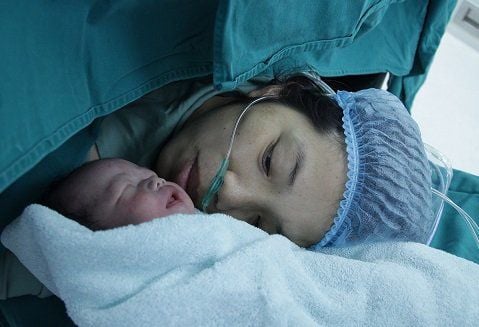This is an automatically translated article.
The article was professionally consulted by MSc Nguyen Cong Canh, Head of Pediatrics - Neonatology Department, Vinmec International General Hospital Da Nang.G6PD deficiency is one of the most common inherited diseases. Currently, it is estimated that 400 million people worldwide have this disease. So what is G6PD deficiency? Is it dangerous and how should it be detected and treated?
G6PD deficiency is a deficiency of the enzyme glucose-6 phosphate dehydrogenase, which causes red blood cells to function abnormally. Patients with G6PD deficiency often have an allergic reaction when they eat lentils or use certain oxidizing chemicals.
1. What is G6PD deficiency?
G6PD deficiency is identified as a recessive genetic disease on the X chromosome, children have this disease because they receive an abnormal recessive gene on the sex chromosome from their parents. Therefore, boys are more susceptible to the disease than girls. The deficiency of G6PD enzyme was determined by doctors due to a mutation in the G6DP gene at point Xq28, where there are more than 140 types of mutations leading to G6PD deficiency. These structural changes disrupt the normal structure of enzymes, reduce the amount of these enzymes in the cells and cause metabolic disorders in the body.
2. Signs of G6PD deficiency in children
Newborns at birth will be tested early to detect congenital diseases including G6PD deficiency. Newborns will be taken by doctors to take dry blood from the heel for testing and analysis. If the results show that the child has a G6PD deficiency, further tests are needed to make a definite conclusion.
For children with G6PD deficiency that are not detected early at birth, parents need to know the typical signs of G6PD deficiency in order to have the right treatment early.
Children with G6PD deficiency when eating lentils or using drugs and foods with high antioxidants will suddenly have an allergic reaction with manifestations such as high fever, headache, abdominal pain, low back pain, heart palpitations. rapid, difficult breathing, jaundice... When the child is taken to the doctor, the test will show anemia due to hemolysis in red blood cells, causing anemia leading to jaundice, yellow eyes, kidney failure. Especially when the baby has severe jaundice at 2 weeks after birth, the damage caused can be very severe, such as cerebral palsy, mental retardation...
In the case of children with G6PD deficiency, there are mild manifestations. No need to worry too much, just avoid foods and drugs with oxidizing properties, ensuring anemia is improved and stabilized. But if the symptoms are more severe and obvious, parents need to send the child to the hospital for proper treatment.
3. Is G6PD deficiency dangerous?
The enzyme G6PD is produced by red blood cells to help protect red blood cells from oxidative damage. Deficiency of G6PD enzyme, red blood cells will be destroyed by oxidants and cause hemolytic anemia. After birth, severe jaundice due to G6PD deficiency will cause many serious injuries such as cerebral palsy, mental retardation and motor retardation.Besides, if not properly treated, prolonged hemolytic anemia along with neonatal jaundice will be a serious problem that children with G6PD deficiency face. Therefore, if a child is found to have G6PD deficiency through early screening, the child should be monitored and parents should be advised to avoid allergens such as lentils and foods and drugs containing antioxidants to ensure their health. healthy for children.
However, it is not because of that that patients with G6PD deficiency are always in danger, they can still live normally with the condition that they do not use foods and foods with the ability to oxidize.

4. What to do when your child has G6PD deficiency?
Doctors said that children with G6PD deficiency should be avoided conditions that may have adverse health effects such as: illness, infection, viral infection, use of pain relievers and fever reducers containing aspirin or phenacetin, taking antibiotics of the sulfonamide and sullfone groups, antimalarial drugs such as quinine, chloroquine, primaquine, using vitamin K to treat urinary tract infections, eating foods made from broad beans, avoiding contact with mothballs, camphor, and should not donate blood.Parents need to remember the following things when having a child with G6PD deficiency:
Do not use drugs, foods or substances that can cause hemolysis Remind healthcare workers about G6PD deficiency in children when take the child to the hospital Do not use camphor, mothballs to put in the wardrobe, blankets, bed pillows... Be wary of some herbal medicines, traditional medicines and legumes because they can contain oxygen Breastfeeding mothers should not use foods or medicines that should not be used in people with G6PD deficiency because they can enter the baby's body through milk Do not arbitrarily buy drugs for children without a doctor's prescription To limit the risk of children having G6PD deficiency, prenatal and postpartum screening is very important. At Vinmec International General Hospital, the PACKAGE maternity care package will include prenatal and postpartum screening tests to detect G6PD deficiency for babies right after birth.
Please dial HOTLINE for more information or register for an appointment HERE. Download MyVinmec app to make appointments faster and to manage your bookings easily.














